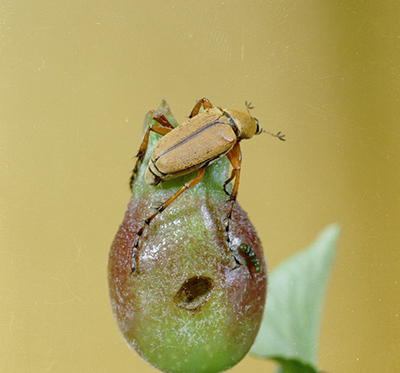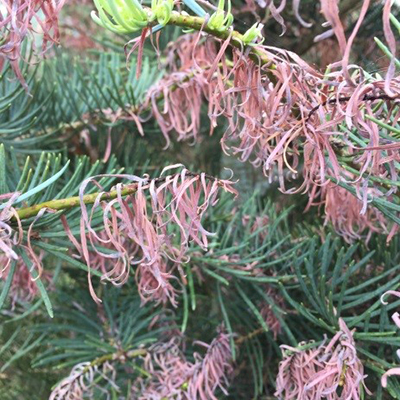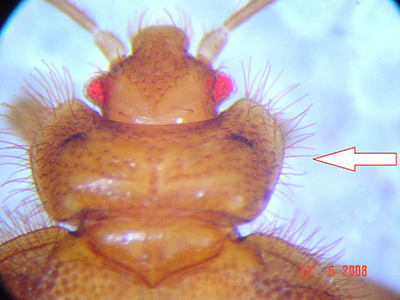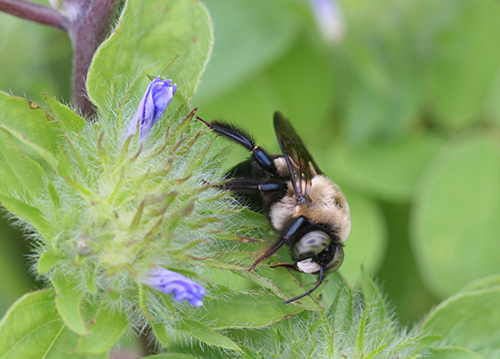Tree, turf and ornamental plant update – June 12, 2018
Maple petiole borers, balsam twig aphids, four-lined plant bugs, rose chafers, bat bugs and carpenter bees are active. Delphinella shoot blight is visible on Concolor fir, and the “Weed Control Guide for Christmas Trees” has been updated.

The following is a summary of current plant development and pest activity for landscape professionals, Master Gardeners, nursery and Christmas tree growers.
Landscapes
Early June is when we begin to see maple leaves dropping. The maple petiole borer larvae finish feeding in the petioles of maple leaves, causing the blackened, restricted petiole (leaf stems) to break and the leaf to fall.
Four-lined plant bugs, Poecilocapsus lineatus (Hemiptera: Miridae), are active now and will feed on a wide variety of herbaceous perennials. This insect gets its common name from the four black stripes present on its front wings of the adults. Nymphs and adults cause characteristic necrotic spots, which might be confused with disease symptoms. There are two to three generations each year, but the most damage is caused by the first generation.
Rose chafers, Macrodactylus subspinosis, are medium-sized beetles, pale green to tan with reddish brown to orange-tinged spiny legs. Rose chafers feed on a number of plants and on flower blossoms, especially peonies and roses, from which they get their name.

Rose chafer. Photo by Clemson University, USDA Cooperative Extension Slide Series, Bugwood org.
Nurseries and Christmas trees
Damage from balsam twig aphids feeding on the foliage of Fraser, balsam and concolor fir is showing up in Christmas tree fields. The damage is to current-year needles, which become curled or wrapped about the shoot. Feeding by the aphids is typically completed by mid- to late June. The foliage will continue to grow and research has shown that the trees will outgrow 40 to 50 percent of the damage by this fall. For more information, read Michigan State University Extension bulletin E2813, “Biology and Management of Balsam Twig Aphid.”
New shoots of concolor fir (Abies concolor) have suddenly turned brown the past week. This damage is caused by Delphinella shoot blight (Delphinella abietis). Infection by Delphinella occurs on the new growth in the spring. Infection just after emergence of the new growth causes the new needles and shoots to shrivel and wilt, much like what would happen due to a late spring frost. If infections occur after the new growth has expanded a bit, symptoms can be limited to the needles with minimal shoot dieback. In mid-summer, as the new needles and shoots die often, we find numerous black fruiting bodies (pseudothecia) on the needle tissue.

Delphinella shoot blight. Photo by Jill O’Donnell, MSU.
“Weed Control in Christmas Trees” (E3237) has been updated. Weed control is an important cultural practice in Christmas tree production throughout the year. Pre-emergence and post-emergence herbicides are needed to minimize weed competition in Christmas tree plantings. The tree species, age, growth stage, size, time of year and soil type must be considered when formulating a herbicide program.
This bulletin covers what you need to know for a successful Christmas tree program. It contains helpful tables regarding appropriate herbicides.
MSU Diagnostic Services
Numerous samples of bat bugs that have found their way into homes have been brought into MSU Diagnostic Services. Bat bugs are close relatives of bed bugs and are very similar in appearance. Their presence in homes indicates bats are also living in the home, most likely in the attic. Bat bugs will bite people if they get hungry enough, however, unlike bed bugs, they cannot reproduce if they only feed on humans.
Control measures for the two are quite different; therefore, it is important to be able to tell them apart. This can be accomplished by comparing the length of the hairs on edge of the pronotum (the part right behind the head). In bat bugs, these hairs are longer than the eyes are wide. In bed bugs, these hairs are shorter than the eyes are wide. For more information on excluding bats, read “Bats and Buildings” from Bat Conservation and Management.
Control measures for bat bugs begin with excluding bats from the premises, then treating bat roosting areas with an insecticide.

A bat bug showing the very long hairs on the edges of the pronotum. The eyes appear red for easy comparison. Photo by Howard Russell, MSU.
We have received a number of calls about carpenter bees, Xylocopa and Ceratina species (Hymenoptera: Xylocopidae). The most common carpenter bee in Michigan resembles many of the closely related, large, yellow and black bumble bees we have here. The top of the abdomen of a carpenter bee is bare and shiny, whereas the abdomen of bumble bees is covered with black and yellow hairs. Even though their native nest of choice would be an old tree, carpenter bees can be serious, wood-destroying insects if they choose your home to build their nest galleries.
Carpenter bee. Photo by Johnny N. Dell, Bugwood.org.



 Print
Print Email
Email


